Former fashion designer Sam Elsom’s ultimate seachange
Making the leap from the fashion industry to cultivating seaweed in Tasmania has allowed Sam Elsom to marry his nerdy passion for science with a bold economic plan.
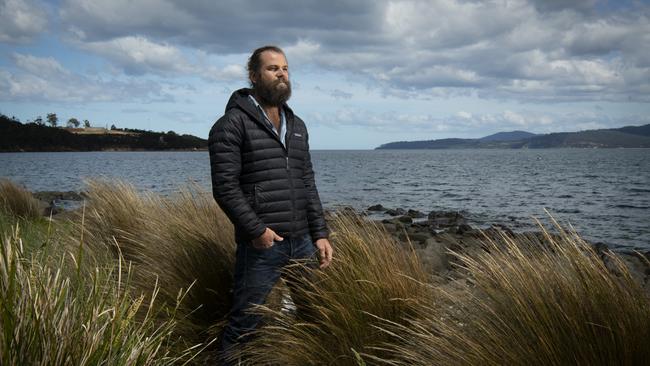
Sam Elsom, fashion designer turned seaweed guy, hollers a genial “hey” from the doorway of a one-storey sugar cube white demountable nestled beside the pristine waters of Spring Bay, on Tasmania’s scalloped east coast. He comes forward with decisive strides, a smile flashing from his hipster beard, his hair gathered into a man bun, and a hearty greeting that peters out into a somewhat parodic elbow shake. “Glad you could find the place,” he says.
I nearly didn’t. The road to Elsom’s seaweed venture, evocatively named Sea Forest, doodles through the port town Triabunna along the foreshore of a deep-water inlet that once serviced the world’s biggest wood chip mill. From the Spring Bay Seafoods company, specialists in blue mussels, he leases the space for his land-based seaweed cultivation pools, science labs, and two chunky mussel boats down on the jetty named Myti Max and Myti Blue.
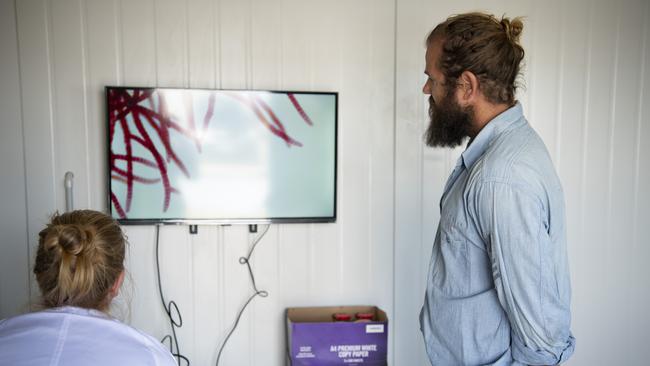
It’s midday when I arrive and the weather is turning; the wind has picked up, the temperature has dropped to a mean nine degrees, and a slurry of bruised cloud is gathering overhead. But Elsom, who is Noosa-raised and now shares his time between Triabunna and Sydney’s northern beaches, is dressed appropriately for the fickle Tassie climate in a padded Patagonia trucker jacket, which he wears over low-slung RRL jeans and scuffed Blunnies.
Crossing one arm over the other while staring across the bay, he explains his plan to save the planet one cow, or sheep, belch at a time.
“Asparagopsis is a species of red seaweed endemic to Australia and New Zealand, and in late 2018 I discovered that it had the potential to reduce methane production in livestock,” he explains. It also has the capacity to accelerate animal productivity without the use of hormones.
“It was CSIRO research I was looking at. The scientists found a certain type of red seaweed could basically eliminate methane emissions in ruminants. Only relatively small amounts were needed – 1 to 2 per cent of the animals’ diet, or 25-30gm per animal a day.”
After immersing himself in the field, he concluded that the big problem was supply: nobody was growing the seaweed commercially. Two years later, his company is cultivating red asparagopsis seaweed on land and at sea, with the aim of drying it to add to animal feed.
Methane is estimated to contribute about 14.5 per cent of anthropogenic, or human-caused, greenhouse gas emissions, and to be many times more potent than carbon dioxide. One of the main sources of atmospheric methane happens to be one of Australia’s key industries: livestock. Therein lies a problem – and a tremendous opportunity.
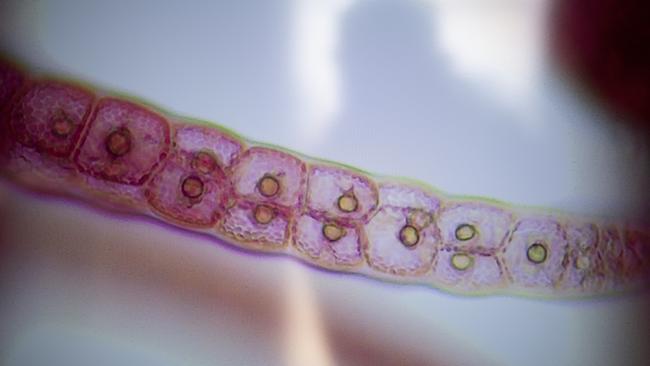
Elsom made his name as a specialist in high-end sustainable textiles and tailoring at the eponymous Elsom Clothing, but his work with the rag trade is in the rear-view mirror when we meet. Seaweed is his metier, his mission. I ask if his wife, fashion designer and stylist Sheree Commerford (the couple have two children Captain and Sugar), ever feels the need to insist that he please not lecture dinner guests about the virtues of seaweed. “That’s exactly it,” he says, bending over and slapping his thigh. “She’s so supportive but it must be borderline driving her crazy! She’s pulled me up a couple of times for talking seaweed in my sleep.”
Seaweed is a marine plant, and a fast-growing one in the right conditions. But Elsom has managed to raise $5 million – his financial backers include surfer Mick Fanning and American entrepreneur Blake Mycoskie – to build a land-based farm to cultivate it, and he’s keen to show me his equipment and what he calls his “mad science”. He’s managed to produce around 10 tonnes – enough to start trials with two Tasmanian clients. There are plans to ramp production up to 355 tonnes a year en route to a projected 3000 tonnes.
He leads the way to an open pool close to the shore. About 20m in length, it’s filled with filtered seawater and baby seaweed. A paddlewheel keeps the nutrient-rich seawater in constant circulation. Elsom dips a hand into this “raceway” and pulls out a handful of russet-coloured seaweed fragments the same hue as his jacket. He insists the colour co-ordination is entirely incidental.
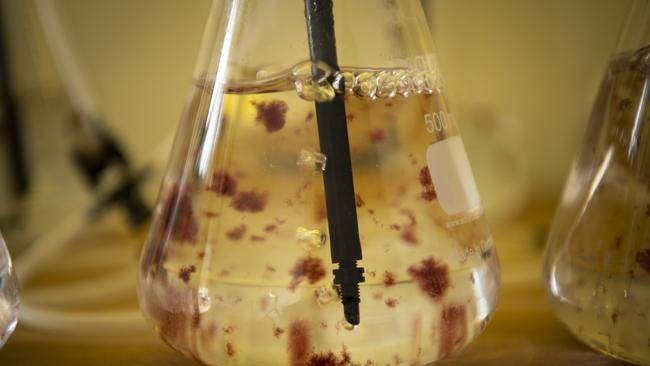
“It’s taken some time for us to understand the complexities of the life cycle,” he says, “to understand the conditions of seaweed reproduction and how we need to approach its cultivation.” As Elsom explains that life cycle, he throws around Latinate polysyllables such as tetrasporaphytes, which grow through fragmentation before reproducing asexually to create gametophytes. I feel like I’m hanging with a particularly hip biology teacher. The gametophytes grow attached to ropes or lines and reproduce sexually. After maturing in the pools on land, they are sent out to a marine farm opposite Maria Island.
I ask Elsom if he has a scientific background and he shakes his head. “Nope,” he says. “But I’ve come to love this stuff. The seaweed we’re looking at is actually de-acidifying the water,” he goes on in the same excited tone. “It’s stripping out the carbon dioxide. The water will be pumped back into the ocean cleaner than when it came in.”
Elsom is no lone champion for the panacea of seaweed, far from it. New businesses are sprouting like topsy around the original and ongoing CSIRO research, which was given a fresh international airing earlier this year when it was published in the respected peer-reviewed academic Journal of Cleaner Production. CSIRO has patented the methane-reducing application of red seaweed in league with the Australian Meat and Livestock Federation and James Cook University. The commercial operation is handled by a new company, Future Feed, which is undergirded by cornerstone investors such as Andrew Forrest, Woolworths and GrainCorp. In December last year the company won a $US1 million Food Planet Prize for efforts to reshape the food system.
According to a report by The Australian Seaweed Institute released last August, the local seaweed industry has the potential to generate $1.5 billion a year by 2040, as well as 9000 jobs and – perhaps most importantly – achieve a 10 per cent greenhouse emissions reduction. The institute’s report recommends further research and development into the application of red seaweed and “large ocean leases” for its cultivation. The mere existence of an Australian Seaweed Institute, with a website featuring “seaweed news”, is a who-would’ve-thunk-it moment signalling the emergence of a buoyant industry, a veritable seaweed rush.
The CSIRO research scientist who pioneered the original work, Dr Rob Kinley, tells WISH: “No other seaweed, and no chemicals, have this effect on methane production. From a greenhouse gas perspective one cow is the equivalent of one car, so that if you feed 100 million cattle with this seaweed it’s like taking 100 million petrol-burning cars off the road.”
The science may be settled, but the fledgling seaweed industry is not. “All dairy and beef industries want this and they want it right away,” says Dr Kinley. “But we don’t yet have enough seaweed.”

Dr Kinley, who is in charge of the R&D for Future Feed, insists that this humble Australasian marine weed has the potential to remake the livestock industry by reducing its carbon profile, while boosting jobs and “scrubbing” seawater of carbon dioxide. “Red seaweed can be sold to one of the great emitters of greenhouse gas [the livestock and dairy industry], where it can knock methane emissions down to next to nothing while improving profitability and at the same time improve the image of red meat and dairy. No wonder the Australian Meat and Livestock Federation is all over it.”
While red asparagopsis seaweed is endemic to Australia and New Zealand – a species named asparagopsis armata is being cultivated by Sea Forest – it has travelled far and wide, hitching rides on the ballasts of boats to most corners of the globe. It’s found in the temperate waters around the UK, North America and the Mediterranean. But Elsom figures he can steal a march on global competitors by developing land-based techniques of cultivation that, if successful, can be licensed to producers around the world so that he exports the know-how, not the seaweed itself. In the meantime, there is a domestic market to support.
From its base at Triabunna, Sea Forest is providing seaweed to Kingston Farm in Tasmania’s northern midlands, source of the superfine wool used by gentlemen’s clothier Matt Jensen in M.J. Bayle’s single-source “Kingston” suits. Simon Cameron, fourth-generation owner of the 3000ha Kingston Farm, told WISH that he plans to set aside 50 of his 5000 merino sheep for a 10-month trial. Half of these will be given the standard feed and the other half will have a diet of grain with an asparagopsis supplement.
The seaweed Elsom grows at Triabunna is also being used by Richard Gardner, owner of Tasmania’s Annandale dairy farm, in a trial sponsored by New Zealand-based global dairy co-operative Fonterra. When WISH contacted Gardner, who has 1320 dairy cows, he said he’d been impressed by Elsom and was “excited” to take part in the trial. “We’re very concerned about this issue,” he said. “We researched it thoroughly and we felt this was the only viable technical solution we’ve seen for dealing with methane emissions. It’s the one most likely to work.”
Gardner sees the capacity of asparagopsis to reduce methane emissions as part of the war against global warming and, at the same time, a way of stabilising the meat and dairy industries. “There’s been some negative marketing against meat consumption because of the industry’s carbon emissions,” he says. “There’s pressure worldwide.” He also expects to see some “productivity increases” as methane that would once have been released into the atmosphere is converted by his cows into energy.
Elsom takes me on a speed tour of Sea Forest. One minute we’re passing through a seaweed maternity ward with a tank of asparagopsis waiting to reproduce, the next we’re inspecting a creche as the infant algae begins to fragment, and fragment again, in preparation for the next stage of life in the “raceway” pool outside.
“I don’t know everything,” he concedes. “After two years at this I’m still learning.” But he knows a lot, and for the pièce de resistance he leads me to a lab where a single thread of asparagopsis lies beneath a microscope. Once the image is enlarged and projected onto the screen the all-important gland cells, coloured a pretty vermilion when viewed at this magnification, are revealed. “You can see how tiny the cells are,” he says. “We’ve got to make lots and lots of them.”
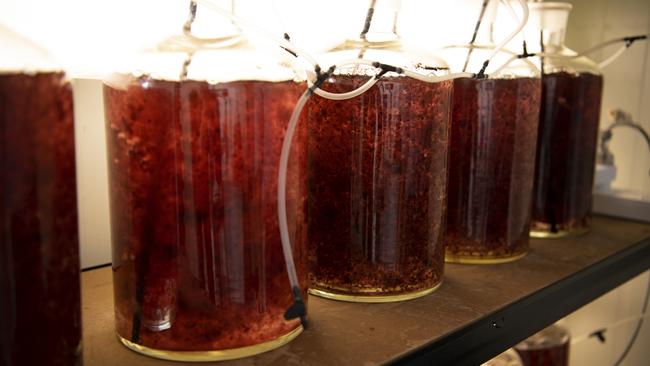
“Australia is one of the most biodiverse places on the planet and there’s a tremendous opportunity to better understand the life of seaweed and its many uses. A lot of seaweed has antifungal and anti-bacterial properties. Aboriginal people used to use seaweed to help heal wounds, and now, centuries later, Deakin University is looking at ways of using it in wound dressing.
“We know so little about something that exists in thousands of species and can be found everywhere in the ocean. One of the most remarkable species of seaweed can be found right here.”
A week later, I call Elsom at day’s end. A full moon has just floated into a sky filmed with light cloud. He’s in a hotel with a bare lightbulb, but moments earlier he was down at the hatchery on the shore. “You should have seen it,” he rhapsodises. “The seaweed were giving birth! There were millions of little baby tetrasporophytes.” And then, after a pause, he reflects. “I’m learning so much about natural biology that my brain is exploding. But what brings me back to earth is the fact that through our activities we’re helping to significantly reduce greenhouse emissions, providing employment, and building the sort of environmentally positive industry the state needs.”

To join the conversation, please log in. Don't have an account? Register
Join the conversation, you are commenting as Logout